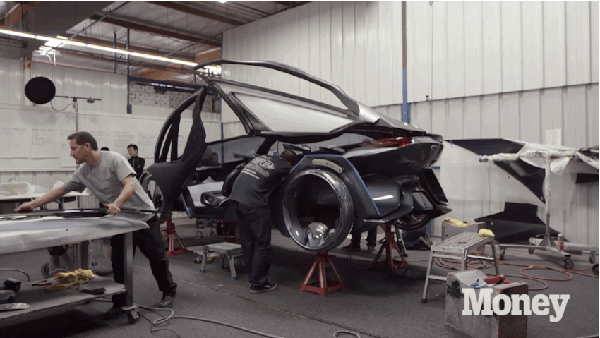This Chevy Concept Car Will Blow Your Mind

Tucked away in a nondescript commercial building in Fountain Valley, Calif., dozens of designers, engineers, and craftsmen have toiled secretively for months on a project that offers a glimpse of the way we may be driving 15 years from now.
Their hangar-like workspace belongs to GFMI Metalcrafters, a company that for decades has built many of the most important concept cars to hit the auto-show circuit. Laboring furiously in its password-protected workrooms, these teams have been assembling a car far ahead of its time.
Meet the FNR, perhaps Chevy’s most unusual concept car to date, and a stake-in-the-ground statement from Chevy’s parent, General Motors.
The FNR, unveiled this week at the Auto Shanghai 2015 car show in China, is a fully autonomous electric vehicle. It’s a family sedan-cum-techno-infotainment solution aimed squarely at China’s youth market — consumers who characteristically respond better to smartphones than sheet metal. The really great news, for real: This is GM’s best guess on what a family vehicle will offer on the affordable front within 15 years.
Chevy hopes that the FNR will hook millennials, not just in China but worldwide, with the promise of a vehicle that will be part Siri, part BFF and part Fitbit. “Everywhere in the world our time is constrained — commute time, work time, family time,” says Sharon Nishi, head of sales and marketing for Chevrolet in China. “Those are some of the things that inspired this car.”
In a departure from current trends in autonomous-vehicle development, Chevy envisions the FNR as a vehicle for the mass market. GM projects that by 2030 — the hypothetical model year for the FNR — self-driving technologies will have proliferated enough to have become less costly, and therefore feasible for a real-world family car. And GM's executives think autonomous vehicles have particularly good opportunities for growth in developing countries like China, where cities and roads are crowding quickly, governments are anxious to resolve congestion, and much infrastructure is yet to be built.
“Design is really important in China,” says Nishi. Appropriately enough, the FNR’s exterior projects futuristic muscle-car attitude. Motors housed in the rims of its massive, hubless wheels will power the car (once that particular innovation is fully developed). The FNR’s sculpted exterior panels are made from composites like carbon fiber, to save weight, and designed with air intakes that add drama and aerodynamic flow to the overall shape.
Double scissor doors open on each side like lotus blossoms. The crowning touch: Thousands of LED lights swathe the vehicle, illuminating it outside and in with a bright blue light, chief designer Cao Min’s ode to Shanghai’s famous evening light shows.
The interior promises that driving itself can be an afterthought, if the user chooses. The FNR would allow occupants to sit back and enjoy the ride in motorized, webbed seats that can read everything from heart rate and blood pressure to mood — and adjust temperature, speed, lighting, and even musical selections for those who want to work or sleep.
Care to swap out the map projected on the oversized canopy to work on some spreadsheets? Simply swipe your hand over the gesture-controlled crystal ball in the center console to reconfigure the display. Of course, that’s assuming you’re in the car at all. The FNR could “take itself to the dealer for service so you don’t have to,” says Mark Reuss, GM executive vice president of global product development.
There’s much work to be done before cars come anywhere close to fulfilling the FNR’s fully autonomous promise. Like other manufacturers and suppliers, GM has gradually loaded more vehicles with active-safety technologies that are precursors to a car that could pilot itself — night vision, blind-spot alerts, lane-change warnings, adaptive cruise control, brake assist. Next year, GM will be the first automaker to bring to market vehicle-to-vehicle communication — cars “talking” to one another to help them avoid collisions — in a 2017 Cadillac CTS. “It’s a step-by-step progression; some of the things we introduced in 2010 and 2011 are now trickling down into our production cars,” says John Capp, GM’s global director of safety strategies and vehicle programs.
Other, more luxury-oriented companies, including Audi and Mercedes-Benz, are closer to putting autonomous vehicles on the road. But GM executives say that by 2030, that may not matter. “How will the consumer interface with and experience all this technology — will it really help, or will it become a secondary burden?” asks Bryan Nesbitt, GM China vice president of design. The automakers that integrate the tech most successfully, Nesbitt says, will come out ahead.
Correction: An earlier version of this post identified Sharon Nishi as head of sales and marketing for GM China. In fact, she is head of sales and marketing for Chevrolet in China.
